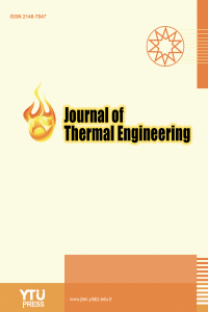Design and development of air ventilated air bed for hospitalized patients
Design and development of air ventilated air bed for hospitalized patients
Air Ventilated Air Bed, Hospitalized patients, Bedsore, Ventilation,
___
- REFERENCES
- [1] Jaichandar KS, García EAM. Intelli-Sense Bed Patient Movement Sensing and Anti-Sweating System for Bed Sore Prevention in a Clinical Environment. In: Proceedings of the 2011 8th International Conference on Information, Communications & Signal Processing; 13-16 December 2011; Singapore. IEEE; 2011. [CrossRef]
- [2] Demarré L, Beeckman D, Vanderwee K, Defloor T, Grypdonck M, Verhaeghe S. Multi-stage versus single-stage inflation and deflation cycle for alternating low pressure air mattresses to prevent pressure ulcers in hospitalised patients: A randomised-controlled clinical trial. Int J Nurs Stud. 2012;49(4):416–426. [CrossRef]
- [3] Vanderwee K, Grypdonck M, Defloor T. Alternating pressure air mattresses as prevention for pressure ulcers: A literature review. Int J Nurs Stud 2008;45:784–801. [CrossRef]
- [4] Beeckman D, Serraes B, Anrys C, Van Tiggelen H, Van Hecke A, Verhaeghe S. A multicentre prospective randomised controlled clinical trial comparing the effectiveness and cost of a static air mattress and alternating air pressure mattress to prevent pressure ulcers in nursing home residents. Int J Nurs Stud 2019;97:105–113. [CrossRef]
- [5] Depypere F, Pieters JG, Dewettinck K. CFD analysis of air distribution in fluidised bed equipment. Powder Technol 2004;145:176–189. [CrossRef]
- [6] Nair P, Mathur S, Bhandare R, Narayanan G. Bed sore prevention using pneumatic controls. In: Proceedings of the 2020 IEEE International Conference on Electronics, Computing and Communication Technologies (CONECCT); 02-04 July 2020; Bangalore, India. IEEE; 2020. [CrossRef]
- [7] Barsocchi P. Position recognition to support bedsores prevention. IEEE J Biomed Health Inform 2013;17:53–59. [CrossRef]
- [8] Manoj R, Kumarasami R, Joseph J, George B, Sivaprakasam M. Continuous weight monitoring system for ICU beds using air-filled mattresses/pads: a proof of concept. In: Proceedings of the 2019 IEEE International Symposium on Medical Measurements and Applications (MeMeA); 2019:1–5. IEEE; 2019. [CrossRef]
- [9] Walton-Geer PS. Prevention of Pressure Ulcers in the Surgical Patient. AORN J 2009;89:538–552.
- [10] Shin JH, Chee YJ, Jeong DU, Park KS. Nonconstrained sleep monitoring system and algorithms using air-mattress with balancing tube method. IEEE Trans Inf Technol Biomed 2010;14:147–156. [CrossRef]
- [11] Rosenthal MJ, Felton RM, Nastasi AE, Naliboff BD, Harker J, Navach JH. Healing of Advanced Pressure Ulcers by a Generic Total Contact Seat: 2 Randomized Comparisons with Low Air Loss Bed Treatments. Arch Phys Med Rehabil 2003;84:1733–1742. [CrossRef]
- [12] Manzano F, Colmenero M, Pérez-Pérez AM, Roldán D, Jiménez-Quintana MM del M, Mañas MR, et al. Comparison of two repositioning schedules for the prevention of pressure ulcers in patients on mechanical ventilation with alternating pressure air mattresses. Intensive Care Med 2014;40:1679–1687. [CrossRef]
- [13] Kandha Vadivu P. Design and development of portable support surface and multilayered fabric cover for bed sore prevention. Indian J Surg 2015;77(Suppl 2):576–582. [CrossRef]
- [14] Takashima A, Misaki A, Takasugi SI, Yamamoto M. Characteristic analysis of an air cell for active air mattress of prevention for pressure ulcer. Adv Robot 2014;28:497–504. [CrossRef]
- [15] Lv B, Luo Z, Zhang B, Zhao Y, Zhou C, Yuan W. Effect of the secondary air distribution layer on separation density in a dense-phase gas-solid fluidized bed. Int J Min Sci Technol 2015;25:969–973. [CrossRef]
- [16] Pawaskar P, Khade S, Patil N, Meshram N, Purandare P. Design and Development of Anti-bedsore Air Mattress. Int J Eng Res Mech Civ Eng 2021;6:39–43.
- [17] Serraes B, van Leen M, Schols J, Van Hecke A, Verhaeghe S, Beeckman D. Prevention of pressure ulcers with a static air support surface: A systematic review. Int Wound J 2018;15:333–343. [CrossRef]
- [18] Chanpur ML, Rajhans NR. Ergonomic bed to reduce bedsores for bedridden patients. In: Proceedings of the International Conference on Ergonomics and Human Factors, HWWE 2011; Pune, India. 2011.
- [19] Shi C, Dumville JC, Cullum N. Support surfaces for pressure ulcer prevention: A network meta-analysis. PLoS One 2018;13:e0192707. [CrossRef]
- [20] Bivolarova MP, Melikov AK, Mizutani C, Kajiwara K, Bolashikov ZD. Bed-integrated local exhaust ventilation system combined with local air cleaning for improved IAQ in hospital patient rooms. Build Environ 2016;100:10–18. [CrossRef]
- [21] Chaudhari K, Mahajan NP, Pande K, Dadhaniya RR, Jarika A. To study the development of pressure sores in chronically bed ridden patients in a tertiary care centre: observational study. Int J Adv Res 2022;10:292–298. [CrossRef]
- Yayın Aralığı: 6
- Başlangıç: 2015
- Yayıncı: YILDIZ TEKNİK ÜNİVERSİTESİ
Madan BASNET, D. SENTHILKUMAR, R. YUVARAJ
Ahmed ALAMI, Lala RAJAOARISOA, Mohammed-hichem BENZAAMA, Abdeldjalil BENBAKHTI
S. Mohamed ILLYAS, Kumaresan VELLAISAMY, A. MUTHUMANOKAR
Heat transfer enhancement of electronic devices by using flexible printed circuit boards
Mustafa EMAD, Sattar ALJABAIR, Ahmed Abdulnabi IMRAN
Experimental study on a novel waterless solar collector
Asaad H. SAYER, Wed AL-GRAITI, Hameed B. MAHOOD, Hameed B. MAHOOD, Alasdair N. CAMPBELL
Shankar DURGAM, Ajinkya BHOSALE, Vivek BHOSALE
Design and development of air ventilated air bed for hospitalized patients
Darshan KARANJE, Shivroop PATIL, Shivraj GURSAL, Prafulla HATTE
Experimental analysis of heat transfer characteristics using ultrasonic acoustic waves
Ali Bousri HAMADOUCHE, Nebbali RICHARD
Determination of optimum insulation thickness in submarines
Savaş DURMAZ, Andaç Batur ÇOLAK, Hatice MERCAN, Ahmet Selim DALKILIÇ
